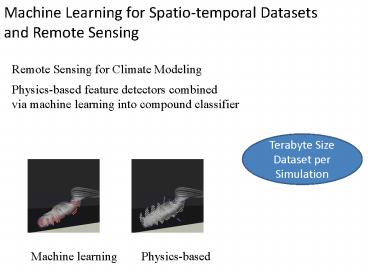Machine Learning for Spatio-temporal Datasets and Remote Sensing - PowerPoint PPT Presentation
1 / 8
Title:
Machine Learning for Spatio-temporal Datasets and Remote Sensing
Description:
Title: No Slide Title Author: jnuetzel Last modified by: CISE Created Date: 12/1/1998 2:51:52 PM Document presentation format: Letter Paper (8.5x11 in) – PowerPoint PPT presentation
Number of Views:135
Avg rating:3.0/5.0
Title: Machine Learning for Spatio-temporal Datasets and Remote Sensing
1
Machine Learning for Spatio-temporal Datasetsand
Remote Sensing
Remote Sensing for Climate Modeling
Physics-based feature detectors combined via
machine learning into compound classifier
Terabyte Size Dataset per Simulation
Machine learning
Physics-based
2
(No Transcript)
3
Change Detection
Objective Identify Changes (damaging changes
due to fires, insects, inclement weather
conditions changes in cropping patterns e.g,
Soy in one year to Corn in the other
year) Data MODIS NDVI time series Existing
Studies Varun Chandola, Ranga Raju Vatsavai A
scalable Gaussian process analysis algorithm for
biomass monitoring. Statistical Analysis and Data
Mining 4(4) 430-445 (2011)
4
Vegetation Classification
Objective Land Use/Land Cover Classification.
Also known as thematic classification is still
challenging task. Challenges include overlapping
signatures, temporal (phonological) dependencies,
soil types and elevation changes, climatic
regions, and more over the subjective definition
of a class. Data Multi-spectral and
multi-temporal Landsat-8 imagery Existing
Studies Varun Chandola, Ranga Raju Vatsavai
Multi-temporal remote sensing image
classification - A multi-view approach. CIDU
2010 258-270 Ranga Raju Vatsavai, Shashi
Shekhar, Budhendra L. Bhaduri A Semi-supervised
Learning Algorithm for Recognizing Sub-classes.
ICDM Workshops 2008 458-467
5
Urban Neighborhood Classification
Objective Identify different types of urban
neighborhoods in very high-resolution satellite
imagery. Often pixel and object based methods
are not sufficient to identify to accurately
identify different neighborhoods (e.g., formal
vs. informal) in satellite imagery and requires
novel approaches to characterize higher-order
spatial patterns. Data Very high resolution
(VHR) areal imagery Existing Studies Object-based
Ranga Raju Vatsavai Object based image
classification state of the art and
computational challenges. BigSpatial_at_SIGSPATIAL
2013 73-80 Multiple-Instance Ranga Raju
Vatsavai Gaussian multiple instance learning
approach for mapping the slums of the world using
very high resolution imagery. KDD 2013 1419-1426
6
Mobility and Physical Activity, Interactive User
Interfaces
- Actigraph GT3X
7
Modeling Mobility Behavior
Terabytes per week
- User Internet Information
- Spatial and location-based information
(buildings) - Temporal information (Sessions times and
duration) - Interest-based information (web domains visited)
- Load and traffic information (flow rate and
packet rate)
Hierarchical Clustering Change Detection
8
Publically Available Datasets
- http//www.quora.com/Where-can-I-find-large-datase
ts-open-to-the-public - http//www.inside-r.org/howto/finding-data-interne
t































